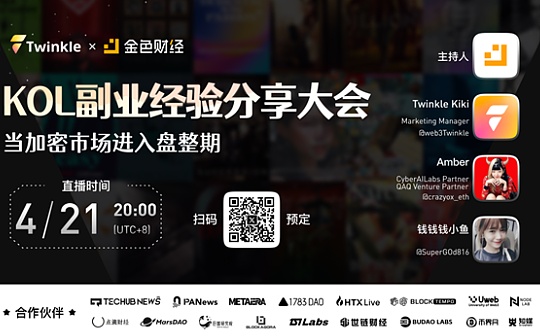What will happen next in the crypto market? Forecast of US technology stock financial report

Reprinted from panewslab
04/22/2025·29DAuthor: Luke, Mars Finance
Introduction: The night before the storm of the Science and Technology
Financial Report Season
On April 21, 2025, the US technology stock financial report season was beating like a war drum, the global market was waiting for breath, and cryptocurrency traders were even more nervous. This week, more than 120 S&P 500 companies will release their first quarter (January to March) financial reports for the 2025 fiscal year 2025. Tesla (April 22), Google's parent company Alphabet (April 24) and Intel (April 24) will take the lead. Microsoft, Meta, Broadcom (April 30), Apple and Amazon (Magnificent 7) will be relayed, and Nvidia is expected to finale on May 28. This financial report feast is not only the focus of Wall Street, but also like a stone thrown into the crypto market, causing layers of ripples.
For crypto traders, the financial report of technology stocks is by no means a financial term that is out of reach, but a lead that directly affects the prices of Bitcoin (BTC) and Ethereum (ETH). The rise and fall of U.S. technology stocks are swaying the Nasdaq and S&P 500 indexes, while crypto assets tend to dance with them.
- In the second quarter of 2020, strong financial reports from Apple and Microsoft pushed up Nasdaq by 6.8%, and Bitcoin took advantage of the situation to break through $10,000;
- In the first quarter of 2022, Meta's weak performance dragged down Nasdaq by 4.2%, while Bitcoin fell 15%.
The Trump administration's upcoming semiconductor tariff policy adds haze to the market. Details are expected to be released before May 7, which may push up chip costs and affect Bitcoin mining hardware and blockchain infrastructure.
Meanwhile, the US dollar index fell below 98 and hit a three-year low, gold soared to $3,400, Trump threatened to fire Fed Chairman Powell, and the market smelled a signal of interest rate cuts - CME data shows that the probability of interest rate cuts in June is more than 75%. Amid this safe-haven boom, Bitcoin broke through $87,000, igniting traders' enthusiasm. This week's technology stock financial report will become a weather vane for the crypto market, and traders must keep their eyes open and grasp their pulse.
Why do technology stock financial reports affect the crypto market?
The financial report of US technology stocks is like a mirror, reflecting the pulse of the global economy and also shaking the nerves of the crypto market. For traders, these financial reports are not only a barometer of corporate performance, but also a key signal that affects position decisions. The following analyzes its far-reaching significance from four dimensions.
1. The resonance between US stocks and crypto markets
The seven tech giants - Apple, Microsoft, Alphabet, Amazon, Nvidia, Meta and Tesla - have a total market value of over $12.5 trillion, accounting for nearly half of the Nasdaq 100 index. Their financial reports directly affect the US stock market, while the crypto market is highly synchronized with the US stock market. CoinDesk data shows that between 2020 and 2024, the average correlation coefficient between Bitcoin and the Nasdaq index reached 0.75, and the rise and fall of technology stocks is like the baton of crypto assets. In the second quarter of 2020, Apple and Microsoft's exceeding expectations pushed Nasdaq to rise by 6.8%, and Bitcoin soared 20%, breaking the $10,000 mark. Conversely, in the first quarter of 2022, Meta plunged 4.2% due to a decline in advertising revenue, and Bitcoin fell from $45,000 to $39,000. In the third quarter of 2024, weak financial reports from Nvidia and Amazon dragged Nasdaq down 2.7%, and Ethereum fell to $2,200. This week, Tesla and Alphabet's financial reports may cause another wave, and traders need to be wary of market chain reactions.
2. The intersection of AI and blockchain
AI and cloud computing are the growth engines of technology giants and also inject vitality into the blockchain and Web3 ecosystem. The revenue growth of Microsoft Azure, Amazon AWS and Google Cloud reflects the enthusiasm of enterprises to invest in decentralized technologies (such as NFT and DeFi). In June 2024, AWS revenue grew 18.7%, and Google Cloud grew 29%, but both were lower than expected, dragging BTC and ETH down 8% and 12% respectively. This quarter, traders will focus on AI monetization capabilities (such as Microsoft Copilot's enterprise adoption, Google Gemini's progress) and capital expenditure. In 2025, the Big Seven AI investment is expected to reach US$331 billion, which may promote the construction of blockchain infrastructure, such as on-chain AI models and decentralized computing power market. However, the low-cost breakthrough of China's AI model DeepSeek has caused the market to question the returns of high computing power investment. On January 27, Nvidia's market value evaporated by US$590 billion, and Bitcoin fell by more than 5% in a single day. Cathie Wood of ARK Invest said: "The rise of DeepSeek may lower the demand for AI hardware, but the distributed computing power of blockchain still has long-term potential." The financial report will reveal the synergistic prospects of AI and blockchain, affecting the valuation of crypto assets.
3. Semiconductor tariffs and hardware costs
Trump's semiconductor tariff policy has laid hidden worries for the crypto market. On April 13, Trump announced the announcement of tariff rates next week, with GPUs and chip manufacturing equipment facing a baseline tariff of 10%. Financial reports from Intel, Broadcom and Nvidia will reflect supply chain pressures, which may drive up the cost of Bitcoin mining hardware and blockchain servers. TSMC's 2-nanometer chip cost may increase by 10-20% due to tariffs, increasing the price of mining machines. Michael Saylor of MicroStrategy warned: "If tariffs push up GPU costs, Bitcoin miners' profits will be under pressure, which may drag down BTC prices in the short term." Traders need to pay attention to the tariff response signals in Intel's financial report and whether the cost pressure on blockchain hardware is mentioned.
4. Macro turmoil and risk aversion
The global business of tech giants is the economic barometer, affecting risk sentiment in the crypto market. Apple's iPhone sales, Tesla's delivery volume reflects consumer demand, and Meta and Alphabet's advertising revenue measure corporate confidence. At present, the macro environment is intensifying: the US dollar index fell below 98 and hit a new low in March 2022, gold broke through $3,400, Trump's threat of firing Powell triggered a Fed independence crisis. Although Republican lawmaker Kennedy expressed support for the independence of the central bank, CME showed that the probability of interest rate cuts in June exceeded 75%.
Bitcoin, as a "hard inflation asset", took advantage of the trend and exceeded US$87,000. Arthur Hayes sighed: "This may be the last opportunity for BTC to be below US$100,000!" In the first quarter of 2022, Meta's weak financial report dragged down Nasdaq, and Bitcoin plummeted by 15%; in 2020, Microsoft's strong performance pushed up the market, and Bitcoin took advantage of the trend to rise sharply. Citi strategist Scott Chronert noted that the earnings report will reveal the level of pricing tariffs and recession risks, providing key guidance for crypto traders.
The undercurrent of Trump's semiconductor tariffs
The Trump administration's semiconductor tariff policy is expected to be released on May 7 at the latest, which may cover chip manufacturing equipment, raw materials and finished chips, pushing up the costs of Intel, Broadcom and Nvidia, and affecting downstream companies such as Apple and Microsoft. In January 2025, tariff concerns caused Nvidia and TSMC share prices to fall 16% and 13%, respectively, while Bitcoin and Ethereum fell more than 8% during the same period. For crypto traders, the impact of tariffs goes far beyond stock volatility. Rising Bitcoin mining hardware prices may compress miners' profits and push up network difficulty; increasing blockchain server costs may drag down decentralized applications (dApps) deployment. Industry insiders analyzed: "If tariffs push up GPU prices, small miners will be eliminated. BTC may be under pressure in the short term, but it is beneficial to the centralized mining pool in the long term."
The potential effects of tariffs include:
- Hardware cost: The cost of 2 nano chips rises by 10-20%, pushing up the prices of mining and blockchain equipment.
- Supply chain adjustment: Companies may move production to the United States, which will benefit blockchain infrastructure stocks (such as Hut 8) in the short term.
- Market fluctuations: unclear tariff guidelines may exacerbate the sale of crypto assets and test traders' risk management.
Intel's financial report this week will provide an early signal for the impact of tariffs, and Nvidia's financial report on May 28 will further reveal the response strategies of AI chips and blockchain hardware. "The uncertainty of tariffs could lead to conservative guidance from tech giants, and the crypto market needs to be prepared for the turbulence," JPMorgan analyst Mark Murphy warned.
Macro background of financial report season
1. Cold thinking about DeepSeek and the AI craze
DeepSeek's low-cost AI breakthrough subverted the expectation of computing power dependence. On January 27, Nvidia's market value evaporated by nearly US$600 billion. Microsoft, Alphabet, and Meta suffered a total loss of more than US$400 billion, and Bitcoin and Ethereum fell by more than 5% in a single day. Meta CEO Zuckerberg said he is studying the integration of DeepSeek technology, but requires more computing power. For crypto traders, the AI boom is closely related to blockchain: decentralized computing power platforms such as Render Network may benefit from the shift in AI investment. Cathie Wood predicts: "Blockchain will play a key role in AI infrastructure." Financial reports will test how giants can balance AI investment with cost optimization, and Nvidia's guidance will directly affect blockchain computing power stocks.
2. Mag7 's valuation and market pressure
In 2025, Mag7's profit growth is expected to slow to 18%, down from 34% in 2024. Microsoft and Meta fell by more than 10%, Apple, Amazon and Nvidia fell by more than 20%, and Tesla plummeted by more than 40%. InvestingPro model shows that Tesla and Apple share prices are above fair value. Wedbush expects tariff uncertainty has made executives reluctant to provide clear guidance and could exacerbate crypto market sell-offs. If the financial report is less than expected, Bitcoin may fall below $80,000, testing the key support level.
Conclusion
The U.S. technology stock financial report season was like a storm, sweeping Wall Street and shaking the crypto market. The performance of Tesla, Alphabet and Intel will set the tone for the fate of Mag7, and Trump's semiconductor tariffs may reshape chip costs and blockchain hardware prices. Historically, the financial reports of technology stocks have repeatedly ignited or extinguished the enthusiasm of the crypto market: the upward wave in 2020 and the plunge in 2022 remind traders that financial reports are a pulse that cannot be ignored.
The crypto market is standing at the intersection of wind and waves. Returns of AI investment, resilience of semiconductor supply chains, the boom of interest rate cuts, and the undercurrent of recession risks will all emerge in the financial report. Dan Ives of Wadebush is optimistic: "The AI party has just begun." But Citi's Scott Chronert reminds: "Financial reports will reveal the truth about risks." Traders need to keep a close eye on this week's financial report, examine positions, and seize opportunities in the undercurrent of volatility.



 jinse
jinse